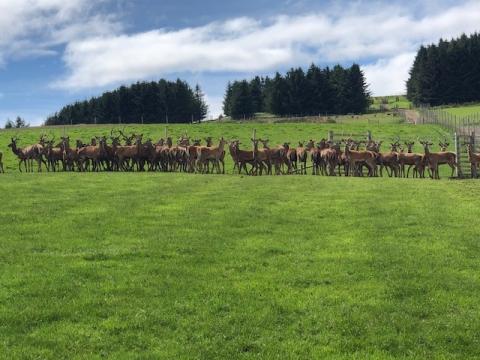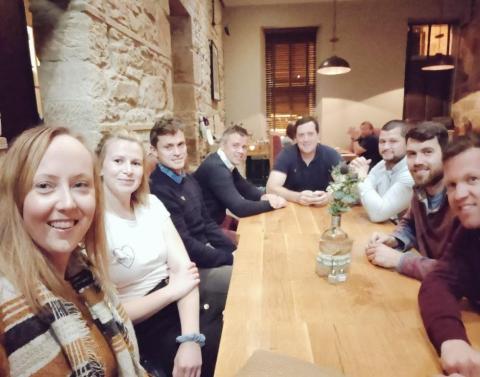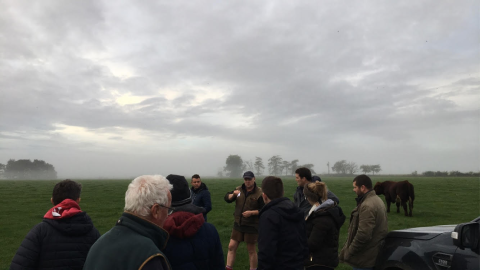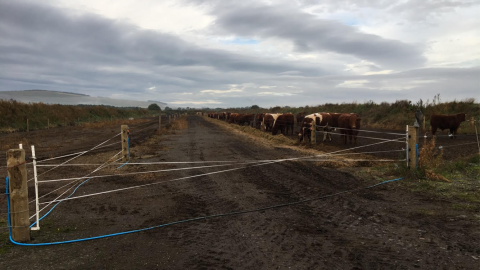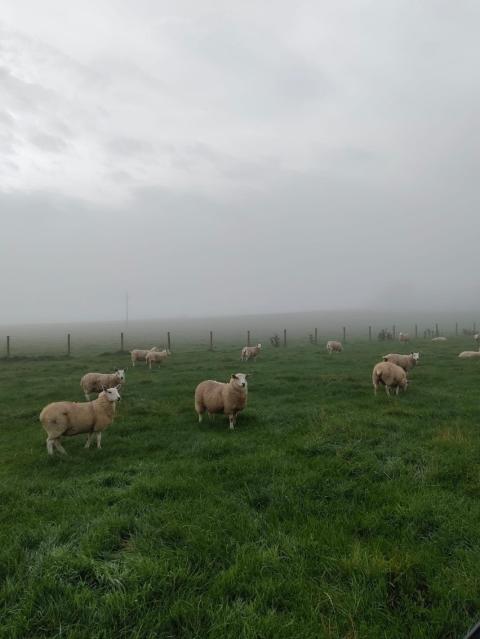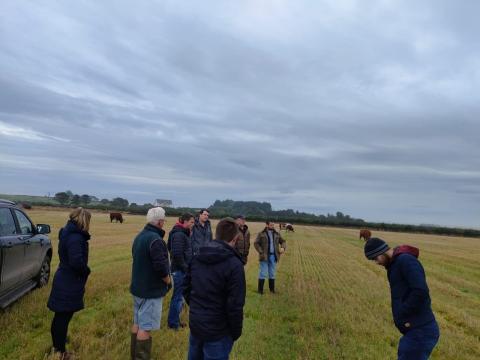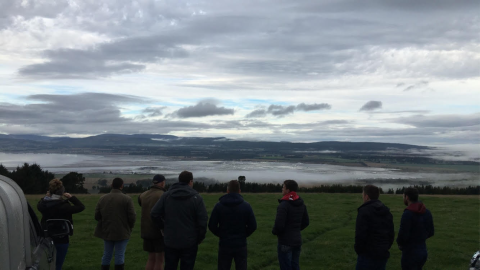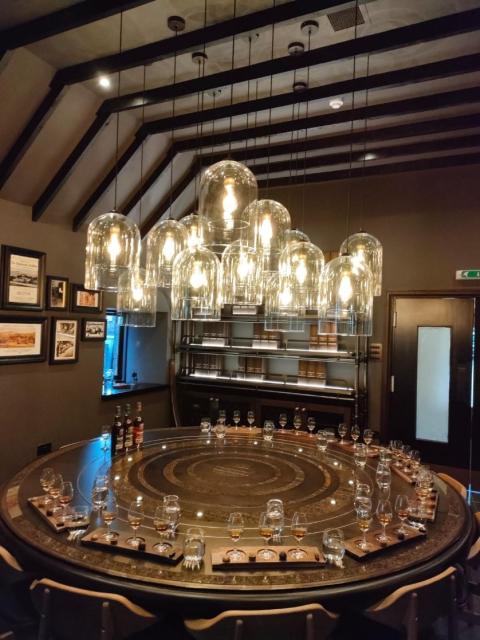Farming Connect Study Visit - Agri Academy Group 2019
Agri Academy Group 2019
Scotland
7-10 October 2021
Attendees
Neil Davies
Gwen Price
Irwel Jones
Heledd Dancer
Llŷr Jones
Eurof Edwards
Rheinallt Harries
Sioned Davies
Rob Powell
Total: 9
Group leader: Neil Davies
Themes and sectors
Cross-cutting themes: Future Generations, Sustainable Management of Natural Resources, Animal Health and Welfare, and Health and Safety.
Sector: Beef, Sheep, Grassland, Arable and Biodiversity.
Core themes: Biosecurity, Lameness, Responsible use of medicines / Countering antimicrobial and anthelmintic resistance, Encouraging animal health planning, Soils, Grassland management, Grazing management, Environmental management, Innovation, Precision agriculture, Business development and Diversification.
Overview of group
This group was formed from the Farming Connect Agri Academy Business and Innovation Programme in 2019. Since then, we have remained in touch as a group with the WhatsApp chat, yet due to Covid, we haven’t been able to meet up in 2020. Therefore, this is a great opportunity to learn more about the agricultural industry and other inspiring businesses. Throughout the Agri Academy programme, we have learnt a great amount about each other, including what our interests are within the industry, and the ventures we would like to take on; therefore, an opportunity to travel and see other ventures in Scotland would be beneficial for us all. As individuals, everyone is strongly connected to Farming Connect, e.g. training courses, Demo Farms, discussion group members and venture programme, and all use the services to improve, for support and to promote to others. The study visit will add value to our previous activities from the Agri Academy programme to view farms, businesses and ventures within the UK (Scotland), which may inspire us to venture onto a new project. The industry is changing, and a lot more changes are forecast, for example, NVZs, deduction of SFP, reduction in antibiotics use etc. Therefore, this study visit will make us re-think the systems we currently have in place – namely dairy, sheep, beef, holiday lets, poultry, and contracting – and highlight how we could improve, in terms of costs, ease of work, safety and marketing.
Aims and objectives
The main aim is to visit a number of farms and business new ventures that could motivate us young farmers to makes changes as the next generation of farmers in Wales.
- Learn about the systems they use, including grazing, stockmanship, feeding, performance and recording data, and see if there are any potential changes that we can make to your home systems.
- Inspire us to venture more by looking at diversification projects across Scotland.
- Looking at improving farm safety and how we could implement it more into our day-to-day work.
- Learn about new technology with grassland/soil management, precision grazing.
Study visit programme
Day 1
Bristol Airport – We all made our way to Bristol airport on Thursday morning, where we caught a flight at 14.05, to arrive at Inverness at 15:30. After a calm flight, we travelled north up to Tain, where we stayed in a local hotel and planned an evening meal at the Platform 1864, which included discussions and catching up with the group.
Day 2
An early start leaving hotel at 07:30to reach our first destination at 08:00: Fern Farm.
The Agri Academy group received a very warm welcome from everyone at Fern Farm, and started our visit in the cattle shed with an outline of business.
John Scott, alongside his father James, commanded the group’s attention on a trip around the farm, viewing the cattle first. Many questions were asked, and a true and honest answer given by John, explaining the difficulties of getting the right staff to work, and the enthusiasm they need to fill the roles at Fern Farm.
Fern farm is a family-run business in its fourth generation, with various different units owned and rented. The main unit was Fern Farm, with 471 hectares, plus 315 hectares of rented land. The main aspirations and goals were to produce high-quality, high-health, performance-recording livestock from a forage and grass-based system, with the total of six full-time employees (with additional seasonal staff when required).
The start of the tour led us to the 25 pedigree shorthorn breeding bulls that are sold annually through their own Yourbid sale and privately. We continued around the farm to see the 100 stud beef shorthorn BSH-X cows and heifers that are spring-calving, following a discussion about the system of out-wintering on grass/forage and only indoor for calving. John also mentioned the 120 cross steers bought in store to fatten and sell to Woodheads, Morrisons, beef shorthorn premium and the buffalo farm butchers.
(Outdoor wintering on air force tracks/fields)
A few miles later, we reached the ewes – a flock of 800 stud ewes and 2,000 cross ewes from a range of breeds from Aberfields, Texel, NZ Suffolk and Beltex tups. Fern Farm have an annual Great from Grass ram sale, when they sell 180 tups annually. Lambing inside and outside begins at Fern Farm on 15 February with the broken-mouth ewes, following with the stud/commercial ewes on 15 March and finishing with lambing 500 ewe lambs (hoggs) on 5 April. The lambs are then sold as store or finished for local butchers and Morrisons.
Lastly, we reached the arable fields, growing 180 hectares of Laureate spring barley that is grown for malting, 20ha of Skyscraper winter wheat for distilling, and many more forage crops for the cattle and ewes – ranging from stubble turnips, forge rape, fodder beet, swedes and kale. Over 3,000 tonnes of silage in the pit and hay are made each year, and all of the contracting work is completed by a local contractor.
As well as this large enterprise and Fern Farm, they also contract-farm 50 cattle and 400 ewes at a different location. In addition to this, John invested in two windmills and biomass boilers to produce heat for the farmhouse and grain dryer. A very recent investment was the holiday cottage on Fern Farm, which can sleep up to 14 people.
The group were overwhelmed by the size of the business, and the amount of work and enterprises going on at one time. However, John highlighted they had some staff issues; he noted that finding the right stockman/woman was difficult in the best of times, and that Covid had made things difficult, with travel and students. Nonetheless, it was clear to see they work extremely hard as a family/team.
The morning flew by at Fern Farm, yet it was time to leave and head down towards Dundee, a three-hour journey, for our next visit at IGS Crop Research. Our visit to the IGS crop research centre showed what some might call vertical farming: an indoor ecosystem where plants thrive through automatically generated and applied growth recipes. In the growth towers, there was a bright light and warm humidity. The fully automated growth tray system of towers manages the light, temperature, relative humidity, water, nutrients and CO₂ levels. It was 100% robotic, with the controls enabled at farm/tower/tray/LED strip level 24 hours a day, 365 days a year. The growth towers have a multitude of technologies on board to allow crops to thrive in the best conditions, with radical cost savings (power, installation, maintenance), with significantly greater productivity, in terms of yield, quality, and consistency. The system was designed to operate anywhere globally with no pesticides (and no crop washing required), and plants were monitored for reaction to recipe changes, which resulted in 30-50% faster crop cycles. The visit to IGS Crop Research opened our eyes to the possibility and the development of new technology.
Day 3
Our first stop was Thorneybank Farm Shop – an eye-opener visit, on a tour with Neil Stephen. Thorneybank Farm Shop has been providing fresh, homegrown and local produce since the 1970s. From field to fork, their veg is picked daily, bringing their customers the finest, freshest produce. They also had home bakes made in-house by Catherine Stephen. Her shortbread is a particular favourite with people worldwide – it simply melts in the mouth! It really is a family affair, with all three Stephen generations very much involved with the day-to-day running of the farm shop. In November 2018, they invested in vending technology to enhance the customers’ shopping experience. The vending machines were the first of their kind in the UK. They are clean, safe and very user-friendly, and both cash and contactless payments are accepted. The fancy pieces are made in-house, and they worked with a small group of trusted local vendors and distributors to bring the finest food products. During our time at Thorneybank Farm Shop, several people came in to buy products, and we could see first-hand how the vending machine worked. It was a privilege to see Eric Stephen himself, and great to see the next generations taking over the business and making changes and developments with the support of their family members, to run the next venture.
Our second visit of the day was to GlenDronach Distillery. Their Highland whiskies are recognised for their deep colour and rich flavour profiles, which range from sweet fruity flavours, from the Pedro Ximenez casks they select, to the dry and nutty notes, from superb Oloroso casks. The tour consisted of sampling three whiskies from their exquisite core range, exploring the art of sherry maturation, and tasting handmade chocolate truffles to complement and expand the flavour experience of the whiskies. Founded in 1826, the GlenDronach was one of the very first licensed distilleries, and has a history of enterprising owners, from the flamboyant James Allardice to the ambitious Walter Scott. Allardice was a colourful character, and stories abound as to how he promoted his whisky with entrepreneurial flair. He was a pioneer of sherry cask maturation, and would have celebrated today’s superb The GlenDronach, maturing whisky in the finest Pedro Ximenez and Oloroso sherry casks. GlenDronach are renowned as the masters of sherry cask maturation; the well-kept secrets have been guarded for nearly 200 years by a parliament of rooks who love the GlenDronach so much, they try to nest in the warehouses! The distillery folk believe as long as the rooks remain at the distillery, it will be good for the whisky.
The third visit of the day included a two-hour journey to Banchory to visit TLC Potatoes. TLC Potatoes has been working with the unique microclimate of northeast Scotland to grow certified, virus-free potato mini-tubers to the highest possible standard. Microplants originating from SASA approved stock are multiplied in the lab prior to growing on, under optimal nutrition and irrigation regimes, in polytunnels.
After harvesting, their top grade mini-tubers are sent to seed potato growers across the UK and Europe, Central and South America, China and South Africa. The group had a tour of both lab and polytunnels to see where the first stem was cut, to the growth of potatoes and also the cold storage facilities. We also had the opportunity to see the different types of potatoes that they grow at TLC. It was an unexpectedly enlightening visit regarding potatoes and the time it takes to develop new types, as well as the work involved.
We had an evening of traveling to Irvine, where we stayed the night and had our evening meal, followed by a surprise planned by Neil and Llŷr (Derwydd), to meet the Agri Academy group of 2021. We had a great evening meeting them all and discussing our time with Agri Academy, and where we are at now.
Day 4
We had an early start at 07:30 to head to Galashiels, for a farm visit with Jim and Jane at Pirntaton Farm. The tour began with an overview of Pirntaton Farm, which is 630ha (530ha effective), with about a quarter of the land being classified as rough grazing. Rising to 1,700 feet above sea level, around 90% of the farm lies at over 1,000 feet. Almost 100ha of the farm is covered by woodland, with a significant proportion of this being planted in 2019/20. Their farming system is based on growing and then utilising as much home-grown forage as possible, with robust, efficient, low-maintenance livestock. This allows them to keep cost of production low, whilst significantly increasing output with the use of rotational grazing and forage crops and minimising purchased feeds. Overall, their production has been lifted from 290-550kgLW/ha whilst purchased concentrate use has been reduced by up to 90%. Jim mentioned they are recording and monitoring performance of both their livestock and pastures. Something that we don’t see often is deer, and Jim spoke to us about the breed/genetics, costs and performance – a bold decision to take on a new enterprise as they came to the realisation that the farm still had huge potential to grow more grass.
COMMERCIAL FLOCK
- Outdoor, April/May lambing commercial flock
- Around 1,300 Mule and Texel crosses, up to a maximum of 1,900 of their NZ Romney composite ewes. With the introduction of the deer enterprise, numbers have now slipped slightly to around 1,750 ewes, which also incorporate Lleyn, Cheviot and Texel genetics.
STUD FLOCK
- 160 un-registered, performance-recorded Suffolk and Texel ewes are used to produce rams for their own use and to sell as shearlings.
- Absolute minimum of concentrate feed used. They focus heavily on the maternal traits, such as lambing ease, mothering ability and lamb survival, as well as the more common terminal traits.
- Rams produced from flock have been 100% forage-fed since 2013. Like in their commercial flock, they practise a strict “no trim” foot policy in their stud flock. Rams are born in April and sold as shearlings annually from August onwards, from the farm by private treaty.
That afternoon was then spent travelling home to Wales. The journey consisted of some thoughts and ‘what’s next’ for everyone in the group. It’s now time to reflect on our travels and integrate what we have learned into our framing practices at home. Many of the group members have some new ventures happening, and this visit made them rethink and evaluate those decisions, regarding farm shops, holiday lets, performance recording, animal health (for example, lameness) and taking risks with new ventures.
The Agri Academy group of 2019 would like to thank everyone for their warm welcome in Scotland, for allowing us to visit farms and businesses, and thank Farming Connect for their continued support and funding for knowledge transfer. The study visit to Scotland provided an invaluable experience for all members who participated, and the effects of the tour will be evident for many years. Thank you also to Neil Davies (Leader) for organising such a full packed study visit.

